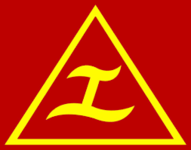Kabataang Makabayan
| Kabataang Makabayan | |
|---|---|
 | |
| Founded | November 30, 1964[1] |
| Headquarters | Quezon City |
| Ideology | Progressivism Nationalism Communism Marxism–Leninism–Maoism |
| Mother party | Communist Party of the Philippines |
Kabataang Makabayan (Tagalog, "Patriotic Youth" or "Nationalist Youth"), also known by the acronym KM, is an underground socialist youth organization in the Philippines which was active from 1964[2] to 1975.[3] It was banned by the Philippine government in 1972 when then-President Ferdinand Marcos declared martial law, and became an "underground" organization.[4][5] It was formally dissolved in mid-1975 along with other National Democratic mass organizations, as part of the National Democratic movement's change of strategy against the Martial Law regime.[3] However, despite the dissolution, the organization is still very much alive, as proven by recent arrests of KM members.[6]
History[]
Kabataang Makabayan originated from the Students' Cultural Association of UP (SCAUP) in the University of the Philippines and was initially organized as the youth arm of the Partido Komunista ng Pilipinas-1930 by Jose Maria Sison, Nilo Tayag and others.[7][8][9] Sison envisioned the youth group as revolutionaries who would establish a country led by the working class instead of oligarchic politicians. It was established on November 30, 1964, Bonifacio Day, to emphasize the continuity of Andres Bonifacio's 1896 Philippine Revolution.[2] Nationalist Senator Lorenzo Tañada gave the closing speech at the KM's first national congress and was a consultant and honorary member.[9]
When Sison re-established the Communist Party of the Philippines (CPP) in 1968 as a consequence of the First Great Rectification Movement, the New People's Army (NPA) was organized as its military wing; Kabataang Makabayan then became the CPP's youth arm.[1] It was also one of the groups that established the National Democratic Front of the Philippines.[2]
First Quarter Storm[]
Kabataang Makabayan was at the forefront of the First Quarter Storm, a period of civic unrest in the Philippines consisting of a series of violent demonstrations, protests, and marches against the government of Ferdinand Marcos from January until March 1970. The protests and subsequent violence they inspired collectively became a major factor that led to the declaration of Martial Law in 1972.[1]
Philippine government sources estimate that Kabataang Makabayan had 10,000–30,000 members at the height of its strength.[10][11]
See also[]
- Anakbayan
- Bagong Alyansang Makabayan
- Diliman commune
- Kabataan Partylist
- League of Filipino Students
- Malayang Pagkakaisa ng Kabataang Pilipino
- Student Movement Philippines (1965–1972)
External links[]
- Kabataang Makabayan calls on the youth to join the armed struggle
- Kabataang Makabayan commemorate 51st founding anniversary in Davao City
References[]
- ^ a b c Pastor, Cristina DC (November 14, 2014). "Kabataang Makabayan as the proverbial Boomer at 50: Are its ideals still relevant?". Retrieved November 25, 2017.
- ^ a b c Palatino, Mong (August 5, 2015). "What Millennials Should Know About the Kabataang Makabayan". Manila Today. Retrieved November 25, 2017.
- ^ a b Santos, Soliman Jr. "Samahang Demokratiko ng Kabataan: some basic information - Europe Solidaire Sans Frontières". www.europe-solidaire.org. Archived from the original on 2020-07-31. Retrieved 2020-10-31.
- ^ Espada, Dennis (November 23, 2014). "Activists share brief recollections on Kabataang Makabayan". Retrieved November 25, 2017.
- ^ Espejo, Edwin G. (March 6, 2008). "COMMENTARY: Springing back to life: The Student Protest Movement". MindaNews. Retrieved November 25, 2017.
- ^ Iñigo, Liezle Basa (February 20, 2021). "150 NPA rebels, supporters yield in Cagayan". Manila Bulletin. Retrieved March 22, 2021.
- ^ Strauss, Julia C.; O'Brien, Donal Cruise (2007). Staging Politics: Power and Performance in Asia and Africa. I.B. Tauris. p. 220. ISBN 978-1-84511-367-4.
- ^ Timberman, David G. (1991). A Changeless Land: Continuity and Change in Philippine Politics. Institute of Southeast Asian Studies. p. 60. ISBN 9813035862.
- ^ a b "Kabataang Makabayan Handbook 1964 (First National Congress, 30 Nov 1964)". Retrieved November 25, 2017.
- ^ "APPENDIX: A History of the Philippine Political Protest". Government of the Philippines. Retrieved November 25, 2017.
- ^ "Proclamation No. 1081, s. 1972". Government of the Philippines. Retrieved November 25, 2017.
- History of the Philippines (1965–1986)
- Student politics
- Communist militant groups
- Youth organizations based in the Philippines
- Youth wings of communist parties
- Youth organizations established in 1964
- Clandestine groups
- National Democratic Front of the Philippines